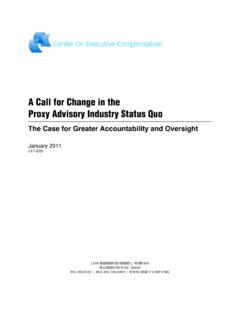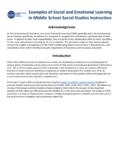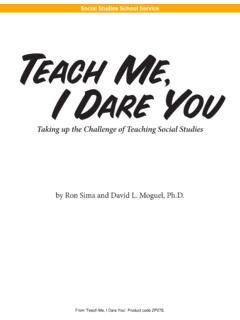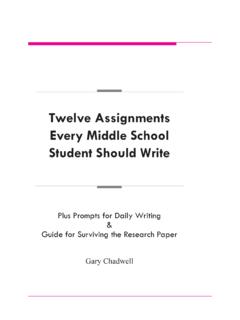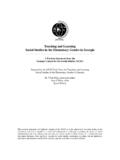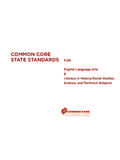Transcription of After-School Programs for Middle School Students
1 After-School Programs for Middle School Students Prepared by: Office of the Mayor Department of Youth and Community Development Department of Education Department of Health and Mental Hygiene Office of Management and Budget March 2014. After-School Programs for Middle School Students 1. OVERVIEW. In keeping with the mayor's commitment, the City of New York (the City) has developed a long-term plan to ensure that all Middle School Students attending Department of Education (DOE) schools have the opportunity to participate in free After-School program- ming. The Department of Youth and Community Development (DYCD) and DOE currently provide 45,095 Middle School student program slots and, on an annual basis, serve an estimated 56,369 Students in 239 schools.
2 The proposed plan will provide $190,000,000 in new funding for School year After-School services. The School year expansion will place Programs in all public schools serving the Middle grades that have no After-School services at the present time, as well as in ad- ditional non-public School sites like community centers and libraries. As a result, starting in September 2014, an additional 62,791 Middle School Students will have the chance to attend free After-School Programs , effectively doubling current service levels. A portion of the funding will also be set aside to enhance currently-funded DYCD Out-of- School Time (OST) Programs by increasing their hours of operation, thereby allowing more Students to participate in After-School activity more days during the week.
3 The proposed program model is based on the best practices in After-School program- ming, including DYCD's OST Programs , and input from DOE and the provider community. Programs will work with School principals to align programming with School -day learning and make special efforts to enroll harder-to-recruit struggling Students , such as those at risk of not being promoted who, research has shown, benefit more than other Students from participation in After-School activities. Principals will be required to contribute in-kind resources to the Programs , by, for example, having teachers take advantage of flexible work schedules that overlap with After-School program hours and providing curriculum resources. After-School Programs for Middle School Students 2.
4 The Middle School years can be a bridge to lifelong success and must play a central role in supporting young adolescents in building foundational academic skills, successful academic and personal behaviors, and in the identification areas of interest and strength. After-School Programs have a vital role to play in the process. Continuing efforts must also be made to address the persistent achievement gap among income and racial groups. Here, too, afterschool can play a part, increasing the likelihood that all New York City Students regardless of family income or neighborhood are college ready by the time they graduate from high School . This plan is the result of a collaborative planning process involving representatives of the Mayor's Office, DYCD, DOE, After-School providers, and youth development experts, who were charged with the task of identifying an After-School model that will meet the need for After-School Programs in all neighborhoods.
5 The city has substantial experience on which to build. The current OST system, which supports a network of After-School Programs administered by nonprofits in schools and community centers, represents a unique partnership between DYCD and DOE, which will be enhanced through the expan- sion. The city has also gained experience from the array of other After-School Programs now operating in public schools, such as Beacon Community Center Programs and 21st Century Learning Centers. After-School Programs for Middle School Students 3. THE Middle School CHALLENGE. Middle School can be an especially challenging time for Students , parents and teach- ers. Early adolescence is a time of positive transition and growth. As they embark on the process of identity formation and start to gain greater independence, Middle School Students are undergoing extraordinary physical, sexual, emotional and cognitive changes.
6 Great possibilities and potential hazards characterize the path to adulthood. Parents know their adolescent children need greater freedom, but want them to do well in School and stay on track for graduation. Similarly, School principals and teachers want their Students to succeed socially and academically, a goal made more challenging as a result of the new higher standards. Encouraging Middle School youth to participate in After-School activities aligned with their developmental needs where they can be with their friends in a productive, safe environment, developing new skills and interests, especially during the hours from 3-6 helps everyone. Engaging After-School Programs that incorpo- rate choice and are relevant to young people can stimulate and inspire Students while delivering educational and social benefits that address the concerns of parents and sup- port the efforts of School -day staff.
7 When such Programs become a focal point for the School and its community, afterschool can become, as Mayor de Blasio has pointed out, a game changer.. Research Findings Regarding the Benefits of Afterschool and Expanded Learning Opportunities Effective After-School Programs provide a variety of activities that engage youth and build their self-confidence, resiliency, and interpersonal skills, while reinforcing School -day learning. The best Programs stimulate curiosity and imagination, while also improving the 21st Century skills needed for success in School and work including self-advocacy, teamwork, communication and critical thinking. With guidance and input from educational experts, After-School Programs can also help struggling Students by reinforcing School - day instruction, providing individual attention, and offering a chance to practice newly learned skills in a supportive setting.
8 A rich body of research and evaluation studies have documented the ways in which participation in quality After-School Programs benefit adolescents. The list of potential benefits is long, reflecting the diverse goals identified by various Programs , which range widely in terms of modalities and duration. At a very basic level, After-School Programs provide a safe place for adolescents to study, socialize with peers, play sports, explore the arts, and establish meaningful relationships with caring adults. Without losing sight of these goals, educators and After-School prac- titioners have in recent years aimed to achieve more specific outcomes related to social After-School Programs for Middle School Students 4. and emotional development and academic achievement.
9 The acquisition of social and emotional competencies is a well-established goal of After-School programming. These competencies include self-awareness, managing emotions and difficult interpersonal situ- ations, ability to demonstrate care and concern for others, establishing and maintaining positive relationships with peers and adults, and making responsible, healthy decisions. Where a program's goal is to help Middle School Students acquire social and emotional competencies, program staff must identify specific competencies as learning goals for individual program activities and clearly articulate what would constitute demonstrations of those competencies. In high quality After-School Programs , activity designs integrate positive youth development principles and cognitive skill development.
10 The research of Durlak and Weisberg has shown that After-School Programs that include a social and emotional learning component can also enhance educational outcomes (discussed below), if activities are well designed, , are sequenced, adopt active learn- ing techniques, focus attention on time and skill development, and establish explicit objectives for the skills being taught. School principals and teachers will recognize these features as components of the standard curriculum map they develop to guide academic instruction during the School day. In considering outcomes related to academic success, it is useful to divide them into two groups: precursor outcomes and academic achievement outcomes. A recent review by Child Trends concluded that After-School Programs are more effective at helping Middle School Students attain precursor outcomes than academic achievement outcomes.







